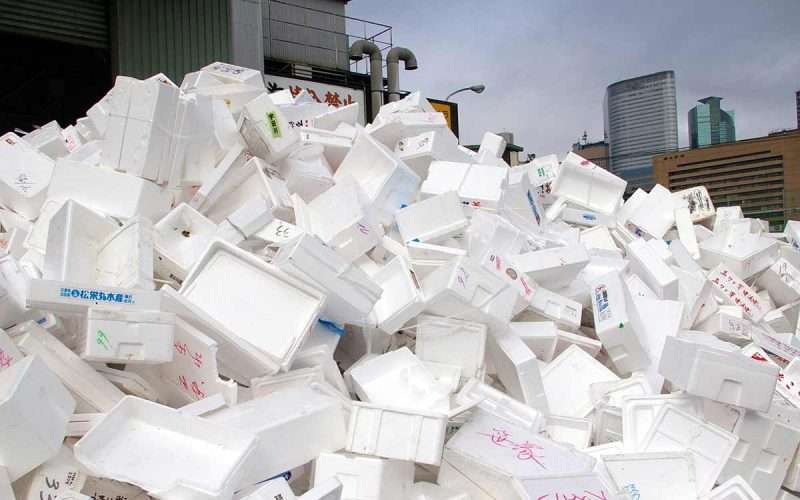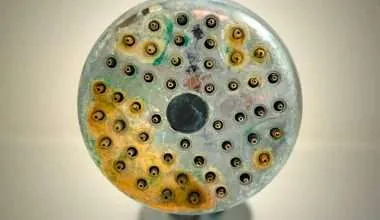Table of Contents Show
What is Styrofoam?
Styrofoam is a type of plastic made up of expanded polystyrene (EPS) It is mainly denoted by the plastic symbol #6. Industries use styrene monomer, an industrial chemical from petroleum and gas byproducts to make this substance. Thus it is inflammable and can cause harm to our health.
Most commonly, this is a single use product which makes it nonbiodegradable. It might never biodegrade and hence, ends up causing pollution.
From takeaway containers to protective packaging of the products, you can see people using them everywhere. Even getting coffee on your way to work, you will observe this pervasive material as a disposable coffee cup in your hand.
Let me tell you that all of these uses of Styrofoam are not good for the environment. You drink the coffee from the disposable cup and throw it into the trash. It is going to stay there forever!
Impact of Styrofoam on the Environment
If we take a closer look at this product, we can notice that it looks like many beads compress together tightly to make it. The beads are very lightweight but are sturdy enough to be used as a protective padding material.
Apart from that, the beads also possess qualities of thermal insulation and contain shock absorption properties as well. Because of all these reasons, people find this material very convenient.
A plus point for businesses is that manufacturing cost is low. And the demand is so much that this material gets an edge in the market.
No matter how beneficial it is for human use, one has to consider its cons. The amount of styrofoam waste ending up in landfills is insane!
If we talk facts, the Environmental Protection Agency states that Americans disposed of around 80,000 tons of styrofoam containers in 2018. And only 5,000 tons of those were able to get recycled. How bad is this?
As this substance is not biodegradable, it cannot break down easily. The worst part about this is that it keeps sitting in landfills and releases greenhouse gases and toxic chemical pollutants. These contribute to global warming while the earth suffers from unwanted climate changes.
Is Styrofoam Recyclable?
According to its usage, you must think that it is recyclable. But unfortunately, you cannot recycle it with any ease. The solid waste goes directly to the landfills and stays there forever.
Recycling styrofoam brings a lot of challenges with it. Recycling regular plastic is easy and is done very conveniently. Additionally, the former does not revert to its basic form for use even if recycled. After recycling, you cannot make anything of it that comes in contact with food.
Moreover, few recycling facilities have the equipment required for the styrofoam recycling process. Due to this reason, one has to make calls to check which recycling facility accepts such products.
To avoid the hassle, people take the easy way and throw styrofoam waste into the trash. So it ends up in landfills, increasing the yard waste. Also, it is bulky because it contains 95% air and is hard to transport.
Furthermore, these products thrown into a recycling bin can contaminate it making it hazardous waste. And because of this, the entire trash barrel can get rejected at the recycling facility.
The reason is that it consists of harmful and toxic chemicals. If these harmful toxins get recycled with all the other waste, they will end up as recycled products that you and I might use at the end of the day.
Downsides of Styrofoam
1. Chemical Exposure
There are a lot of different harmful chemicals that this material consists of. These chemicals are hazardous for the human body as well as the brain. The main styrofoam manufacturing chemicals are styrene, benzene, and ethylene.
The building block of this substance is styrene. It is a strong chemical. Exposure to this chemical irritates the eyes and can cause gastrointestinal problems also.
Long-term exposure to this chemical can lead to a severely damaged nervous system.
The second harmful chemical in styrofoam production is benzene. It is a cancer-causing chemical. It can also lead to leukemia and bone marrow damage.
Third is ethylene, a highly toxic chemical that can cause a lot of damage to humans.
Workers in styrofoam manufacturing factories are at high risk because they are directly in contact with these harmful chemicals. Whereas, the consumers of these products are not particularly affected because they are not in direct contact with these chemicals.
2. Not Biodegradable
Since it is not biodegradable, it takes many years to break down naturally. Most synthetic products are biodegradable, unlike this matter.
Most of it ends up as a waste product because people find it difficult to recycle it even though it can get recycled. When it ends up in a landfill, it litters it by staying there for many years and also takes up a lot of space. Therefore, we are facing the problem of overflowing landfills.
An important environmental issue such as congested landfills is worrisome. Burning this material is not a sensible solution as well. This is because burning it releases carbon monoxide into the air which is highly harmful and contributes to air pollution unnecessarily.
3. Chemical Leaching
When you use it for food takeaways, the high heat from the hot food causes a minute amount of styrene to leach out. The hazardous chemical leaches out of the styrofoam boxes and penetrates the food inside the container.
It is not advisable to use these containers for hot food as the leaching of chemicals is toxic to human health. It acts as a neurotoxin if consumed in high amounts.
4. Use of Petroleum
Another thing used in its making is petroleum, a non-sustainable polluting resource. The production processes cause emissions from petrol and its products.
These emissions are hazardous to the environment since they contribute to the rise of global warming
What can we do?
1. Go for Alternatives
Like there is pressure to reduce the use of plastic, all of us should minimize the use of polystyrene foam for the betterment of our environment. To do so, one must stop using disposable plastic and move towards reusable boxes and cups.
Using reusable products such as a reusable cup for your coffee will eliminate the need for a styrofoam cup. Similarly, for takeaway food, if you start using reusable containers for ready meals, there will be no need for styrofoam containers which have to be disposed of after use.
2. Do not Throw Away Carelessly
Sometimes when you cannot avoid it and need to use it, then make sure to dispose of it properly. If you directly throw it away in the trash, then you are at fault. You should drop it at a recycling facility that does styrofoam recycling.
If you do not wish to take it to a recycling facility, avoid the mistake of throwing it in a recycling bin. The reason is that it can contaminate the whole bin that will not be able to get recycled.
3. Go for Sustainable Brands
As a responsible human being, you must get into the habit of buying sustainable, ecologically friendly products. When you are shopping, make a habit of observing the packaging of the products.
Better buy from brands that use biodegradable, compostable, or upcycled packaging. These are all sustainable options that should be opted for concerning doing something good for the environment.
Add to this is the point that buying from sustainable brands motivates them to do better in this field. And it also inspires other brands to become sustainable to increase their sales.
Prioritizing sustainable business practices should be a common shared goal among people.
Frequently Asked Questions
1. What is the difference between Styrofoam and polystyrene?
Ans. Styrene monomers produce Polystyrene. Styrofoam is a form of Polystyrene. The main difference between the two is that polystyrene is a form of synthetic aromatic hydrocarbon polymer whereas, Styrofoam is a commercial brand of polystyrene.
Although it is a brand name, it is widely used in the place of polystyrene as Band-Aid is used widely in the place of bandages!
2. Does Styrofoam absorb water?
Ans. Styrofoam is not fully waterproof. It does not absorb moisture from the air but can soak up water if it directly comes in contact with it.






